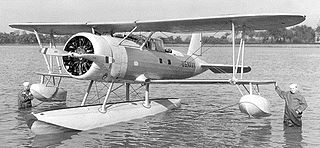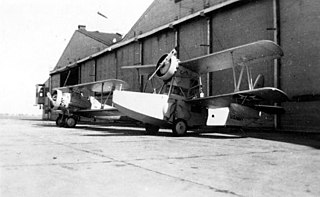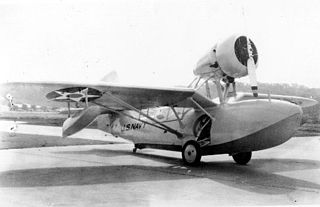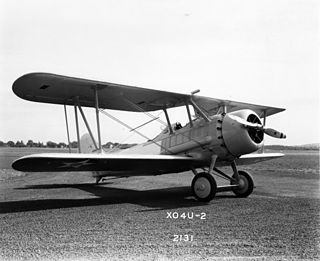 W
WThe Bellanca SE was an American carrier-based scout monoplane designed and built for the United States Navy by the Bellanca Aircraft Company.
 W
WThe Bellanca XSOE was a prototype American scout observation floatplane built for the United States Navy by the Bellanca Aircraft Company. It was never accepted by the Navy and only the prototype was built.
 W
WThe Berliner-Joyce OJ was an American biplane observation floatplane developed by the Berliner-Joyce Aircraft for the United States Navy during the early 1930s.
 W
WThe Curtiss O-40 Raven was an American observation aircraft of the 1930s which was built and used in small numbers. A single example of the YO-40, a single-engined Sesquiplane with a retractable undercarriage was built, followed by four examples of a modified monoplane version, the O-40B, which remained in use until 1939.
 W
WThe Curtiss SOC Seagull was an American single-engined scout observation seaplane, designed by Alexander Solla of the Curtiss-Wright Corporation for the United States Navy. The aircraft served on battleships and cruisers in a seaplane configuration, being launched by catapult and recovered from a sea landing. The wings folded back against the fuselage for storage aboard ship. When based ashore or on carriers the single float was replaced by fixed wheeled landing gear.
 W
WThe Douglas A-20 Havoc is an American medium bomber, attack aircraft, night intruder, night fighter, and reconnaissance aircraft of World War II.
 W
WThe Douglas O-31 was the Douglas Aircraft Company's first monoplane observation straight-wing aircraft used by the United States Army Air Corps.
 W
WThe Douglas O-43 was a monoplane observation aircraft used by the United States Army Air Corps.
 W
WThe Douglas O-46 was an observation aircraft used by the United States Army Air Corps and the Philippine Army Air Corps.
 W
WThe Douglas XO2D-1 was a prototype American observation floatplane of the 1930s. It was a single engined biplane intended to be launched by aircraft catapult from ships of the United States Navy, but only one was built, the production contract going to Curtiss for the SOC Seagull.
 W
WThe Great Lakes XSG was an amphibious observation aircraft developed in the United States in the early 1930s for a US Navy competition. It was an ungainly and unorthodox biplane design with a single large pontoon mounted below the lower wing. This pontoon extended rearwards and carried the conventional empennage. On top of the lower wing, where the fuselage would normally be located, was a stubby nacelle containing the tractor-mounted engine and the pilot's cockpit. The rear of this nacelle was semi-enclosed with glazing and incorporated a position for a tail gunner. The main units of the wheeled undercarriage retracted into the sides of the central pontoon.
 W
WThe Loening XS2L was an American biplane scout amphibian developed by Keystone-Loening, for the United States Navy during the early 1930s.
 W
WThe Loening SL was an American submarine-based reconnaissance flying boat designed and built by Loening Aeronautical Engineering for the United States Navy.
 W
WThe Naval Aircraft Factory XOSN was an American biplane observation floatplane developed by the Naval Aircraft Factory for the United States Navy during the late 1930s.
 W
WThe Pitcairn OP-1 was the first rotary-wing aircraft to be seriously evaluated by any of the world's major air forces. The machine was not a helicopter, nor an airplane, but an autogyro. Pitcairn's model was never put into production for any military.
 W
WThe Pitcairn PA-34 and Pitcairn PA-33, given the United States Navy (USN) designation Pitcairn OP-2 and United States Army designation Pitcairn YG-2 respectively were reconnaissance auto-gyros designed and built in 1936 for evaluation.
 W
WThe Sikorsky XSS was an American two-seat amphibious flying boat built by Sikorsky Aircraft for evaluation by the United States Navy in 1933, for carrier-borne and/or catapult-launched scouting duties.
 W
WThe Stearman XOSS was an American biplane observation floatplane developed by Stearman Aircraft for the United States Navy during the late 1930s. Intended to replace the Curtiss SOC Seagull in service aboard battleships, it proved inferior to the Vought OS2U Kingfisher in a fly-off, and did not enter production.
 W
WThe Vought O4U Corsair was the designation applied to two different experimental biplane scout-observation aircraft. Neither reached production or entered regular service.
 W
WThe Vought O5U was a 1930s prototype American observation floatplane to meet a United States Navy requirement for a catapult launched scouting aircraft. The contract was won by Curtiss who went on to produce the SOC Seagull; only one O5U was built.
 W
WThe Vought OS2U Kingfisher is an American catapult-launched observation floatplane. It was a compact mid-wing monoplane, with a large central float and small stabilizing floats. Performance was modest because of its low-powered engine. The OS2U could also operate on fixed, wheeled, taildragger landing gear.
 W
WThe Vought XSO2U was an American observation floatplane developed by Vought-Sikorsky for the United States Navy during the late 1930s. Intended to replace the Curtiss SOC Seagull in service as a scout aboard cruisers, it proved superior to the Curtiss SO3C in evaluation, but failed to win a production contract due to Vought's lack of manufacturing capacity.